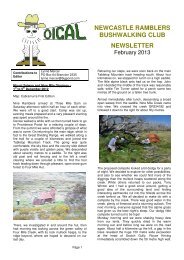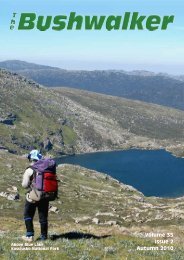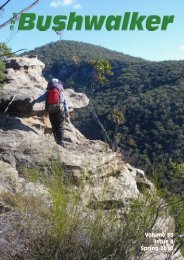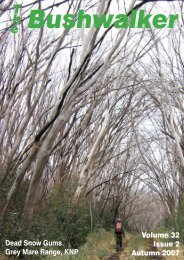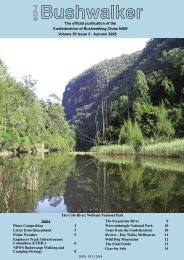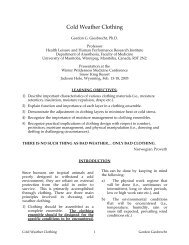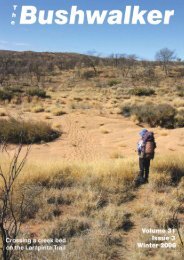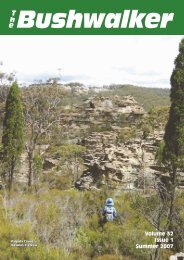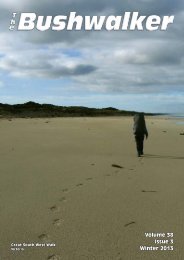Vol 37 No 2 - Confederation of Bushwalking Clubs NSW
Vol 37 No 2 - Confederation of Bushwalking Clubs NSW
Vol 37 No 2 - Confederation of Bushwalking Clubs NSW
You also want an ePaper? Increase the reach of your titles
YUMPU automatically turns print PDFs into web optimized ePapers that Google loves.
Wouldn’t you like to be here?Hiking in the Zanskar region <strong>of</strong> Ladakh, from Padum to Lamayuru.Photo: Nina GalloPagodas, Capertee region.Photo: Michael Keats, The Bush Club
Walk Safely—Walk with a Clubtime to investigate but we needed to pressahead. Next, we went around andunderneath a headland that resembles atadpole on the map. Initially Ian haddrawn our course over the top <strong>of</strong> the it,but now we were here we realised thatthe sides <strong>of</strong> the ‘tadpole’ were in fact 50 mcliffs that didn’t rate a mention on thetopographical map. Such is Wollemi.At 0810, we were at the junction <strong>of</strong>our creek with another one, coming againfrom the right. Our plan was to climb out<strong>of</strong> the gorge at this point, which had beenidentified by Ian and I during our recce. Itwas time to fill up with water for the dayand also to shed our wet weather gear. Iknew it had to be done, but the feeling <strong>of</strong>my shirt, very cool and still wet from thelast night’s dew against my skin was notentirely enjoyable.At 0814, we started our climb up tothe high ridge in front <strong>of</strong> us; the totalascent was in the order <strong>of</strong> 200 m. The firstbit <strong>of</strong> it was very steep and involved acrawl through debris <strong>of</strong> a recently fallentree, followed by a crawl on a tiny ledgeabove a fairly significant drop – all withthe full pack. Soon after the scrub becameless dense and we came upon a beautifuldry cave, with s<strong>of</strong>t white sandy floor andtwo interconnecting chambers separatedby a single, jagged, intricately incisedcolumn.Things got even easier as we emergedinto a drier and less inclined slope.The ridge gradually swung from the southwest to the south and became rather flat,affording views <strong>of</strong> Mount Coricudgy in thedistance to our north north west. Next, wecrossed a large hanging swamp full <strong>of</strong>magnificent spring wildflowers.At the far edge <strong>of</strong> the swamp, we sawwild dog or dingo scats on a small rock.Throughout the entire Traverse, we hadDrying gear in the sunnot seen or heard one but this proves thatthey are around. We continued to enjoygreat views <strong>of</strong> Mount Coricudgy, theKekeelbon Mountains and MohawkMountain to our north – all <strong>of</strong> them weregetting more and more distant, hazier,bluer in colour with every step and weresoon to become only memories.As the old vistas were fading away,new ones were appearing to keep usdelighted and amazed. We stepped on anarrow, elevated, rocky ridge that hadamazing, expansive views in all directions.In addition to the landmarks to thenorth, we could see all the way to thesouth, to the cliffs and mountains <strong>of</strong> CaperteeValley, our next destination in twodays time, if all went according to plan.The place was right, the time was right, soit was morning tea at 0938. We also neededto use this opportunity to dry our gearfrom the last night’s dew. We unrolled oursleeping bags and spread them in thewarm sun. They were beautifully dry andfluffy within minutes.Morning tea was over at 1000, thetemperature was 12 C, although it felt alot warmer in the strong sun. The ridgecontinued to delight us. It was different tothe rocky saddles <strong>of</strong> the <strong>No</strong>rthern Wollemiwith their orange weathered rockoutcrops that form parts <strong>of</strong> the ridges.This spur was an almost flat, solid rockplatform <strong>of</strong> dark brown colour, with largeindividual boulder pieces scattered on itssurface in a very artistic and picturesquefashion. From our elevated walkway wecould see that the ridges, valleys, deepgorges and pagoda fields in all directionslook very interesting as well. This area isnot easy to access and I am sure athorough exploration would yield manyamazing discoveries. I called this longridge that extends for about one kilometre25th AnnualNavShield6th & 7th July 2013THE <strong>NSW</strong> Emergency ServicesWilderness Navigation Shield(NavShield), is an overnightevent where teams attempt togain as many points as possibleby finding their way on foot,through unfamiliar wildernessterrain to pre-marked checkpoints.The course covers anarea <strong>of</strong> 80 to 100 square kilometresand only traditional mapand compass techniques arepermitted. The course is set bya team <strong>of</strong> skilled navigatorsfrom the Bushwalkers WildernessRescue Squad (the oldestland search and rescue unit inAustralia) - the <strong>of</strong>ficial Search &Rescue arm <strong>of</strong> <strong>Bushwalking</strong><strong>NSW</strong>.The course will be set in asecret location (within 2 hours<strong>of</strong> Sydney) and will take placeon the first weekend <strong>of</strong> July2013. It’s an ideal trainingopportunity for your clubmembers to learn and practicein a fun and enjoyableweekend. You can choose tomake it as competitive or asamateur/fun as you like!NavShield is the primaryfundraising activity for BWRS, socome and support your Searchand Rescue Squad, whilstpromoting a great, fun event toyour <strong>Clubs</strong>. Proudly supportedby the <strong>NSW</strong> State Rescue Board,the event is open to rescueteams from around the world.Past events have seen entriesfrom a variety <strong>of</strong> <strong>Bushwalking</strong>and Rogaine <strong>Clubs</strong>, Police,Ambulance, Rural Fire Service,State Emergency Service,<strong>Vol</strong>unteer Rescue Associationand the Armed Forces.Registrations for this year’sevent are now open and allinformation is available on theSquad’s website,www.bwrs.org.au.<strong>Vol</strong>ume 38, Issue 2, Autumn 2013The Bushwalker | 5
Walk Safely—Walk with a ClubThe “cow”and provides a wonderful transition from<strong>No</strong>rthern Wollemi to Southern Wollemi,Scenic Ridge.The splendours continued. On top <strong>of</strong>the opposite spur, across a deep canyon,there was a huge rock that looked like agiant cow, perhaps 20 m long and 5 mhigh. This was followed shortly after by arock shaped like a giant chicken. Walkingalong the Scenic Ridge, we crossed ontothe Coorongooba topographical map – our4th map out <strong>of</strong> the total <strong>of</strong> 11.The weathered lumps <strong>of</strong> rock coveringthe ridge were generally dry but in manyplaces their southern side had moisturerunning on the surface, nurturingwonderful quilt works <strong>of</strong> mini-carpetsmade <strong>of</strong> tufted green grasses and brightflowering plants. These would <strong>of</strong>ten bepositioned next to large expanses <strong>of</strong> rustyred lichen.Afew minutes later, we came across anunexpected find in the middle <strong>of</strong> WollemiWilderness - several (about 10) usedplastic blank cartridges scattered on theground. These cartridges would have beenfired many years ago. About a kilometrebefore this spot, we saw the remains <strong>of</strong> anold camp, so our theory is that the Armygroup that built the Army Road (whichwas only about 3km to our west) hadtheir manoeuvres here in the past and hadthe camp we saw earlier as one <strong>of</strong> theirbases.Suddenly, we saw a tall column <strong>of</strong>white smoke coming from a ridge severalkilometres to our west. The fire wasburning on a steep slope in an area thatwas probably outside the National Park.For the next few hours, while the fire wasin view, we kept a close eye on it. It didn’tseem to spread any further from therelatively small area it first appeared in.We never found out whether or not it wasdeliberately lit.At 1215 it was lunch time on a highrock suspended above a stunning, deepgorge framed with hundreds <strong>of</strong> highpagodas and running south from ourpresent position. Much further south, wehad an expansive distant view <strong>of</strong> CaperteeValley, and to the south west <strong>of</strong> the TyanPic. The map in fact shows that the gorgebelow us continues for more than 2 kmbefore joining Ovens Creek. If only wehad time to explore it, but our plans fortoday were different. The immediateagenda was to rest and to satisfy ourhunger, and the further one was to reachOvens Creek by the end <strong>of</strong> the day. As wehad had a very long and difficult dayyesterday, we didn’t want to do that againbut rather try to have a relatively earlycamp.At 1244, it was the end <strong>of</strong> lunch time,and my routine temperature measureshowed a very pleasant 19 C. The areaahead <strong>of</strong> us looked particularlychallenging or ‘messy’ as Ian put it, bothon the aerial images and now in reality infront <strong>of</strong> us. First, we scrambled down ontoa rocky, narrow spur to the west <strong>of</strong> thegorge we had been sitting above atlunchtime. Very soon we found that thespur is not a contiguous one and is hardto read as it has lots <strong>of</strong> ‘orphan’ outcrops;you climb on one <strong>of</strong> them, walk for ahundred metres or so, then when facedwith an impossible drop you realise thatyou are actually not on the main spur buton an isolated high rock and so need t<strong>of</strong>ully back out. This exercise had to berepeated several times in the course <strong>of</strong> theafternoon. Naturally, the 1:25,000topographical map cannot give you muchguidance in this terrain.After about half an hour <strong>of</strong> doing this,we came to an abrupt gash in thespur with a 10 m drop and no apparentway to get down. Of course, there is alwaysa way, or at least most <strong>of</strong> the time!We soon located a slot with a chockstonejammed in it about 2 m below a narrowledge where we could just stand, one at atime. This was a little similar to one <strong>of</strong> thedescents in the <strong>No</strong>rthern Wollemi on Day1. We took the packs <strong>of</strong>f and, one by one,carefully lowered ourselves down onto thechockstone, then scrambled further down,squeezed ourselves underneath the chockstonethat was suspended in mid-airabove us and pushed our way through theslot that stopped at a tree before reachingthe bottom. The scramble down aroundand through the tree finally led us underneaththe cliffs.The huge chockstone we had just goneunder was shaped like a guillotine, withits enormous sharp blade pointing down.It was held in the slot between two rocksby friction and didn’t seem all that stable.Whilst Rodney was squeezing underneathit, I asked him to pause for a photo. Hecomplied, but for some reason it lookedlike he didn’t appreciate my request,neither did he enjoy the experience <strong>of</strong>standing still at that location.In the end, we all completed the descentsafely, and on the way I even picked upa Sarsaparilla leaf to chew on from a vinegrowing in the slot. This helped in thenext section as it was an ascent on theridge that very soon became broad, scrubbyand viewless.At 1340 we took a sharp turn to theright (west) and started our descent intoOvens Creek. After about 60 verticalmetres <strong>of</strong> descent the ridge we were onstopped at a sharp and very deep gully,not shown on the map. This meant wehad to get down and around the obstacle,then climb back up on the ridge.At 1418 Ian located the gully he hadintended to take for the final descent andwe plunged into it. The gully was steepand covered with debris and fallen rocks.Very soon it developed into a veryThe rocky ridge ahead6 | The Bushwalker <strong>Vol</strong>ume 38, Issue 2, Autumn 2013
Walk Safely—Walk with a ClubRock, rock and gorgeimpressive, cliff lined, broad gorge, about 60 metres across.This enabled us to choose the best course <strong>of</strong> descent byveering from one side <strong>of</strong> the gorge to another as we wentdown.Ian accidentally dislodged a dead part <strong>of</strong> a tree, about 4m long, that dropped down from above, pointing verticallyat him, within a hair breadth from his head. He steppedaside nimbly, avoiding a more serious encounter with thesharp, pointy trunk. I heard a crash in front <strong>of</strong> me andwatched the whole action as though in a slow motion, eventhough it took seconds to unravel. Phew, that was close!We carried on. The gorge now opened even more,becoming a very pretty looking valley, lined with majestic,high trees, their shining white trunks rising to the sky fromthe high grasses below. The bird songs here wereparticularly sweet and beautiful, welcoming us to thisworld that most probably had never before been visited byanyone that looked like us. The descent was slow, however,because <strong>of</strong> the debris and low level scrub.At 1445, just over an hour since starting the descent, wewere finally on the valley floor, in the wild, dark, moistand mysterious rainforest. Like many times during this journey,I had a feeling that this is one <strong>of</strong> the last wildernessfrontiers and that we were stepping into a virgin, wonderfuland unexplored territory.Although the creek itself and the rainforest around itwere beautiful, the gorge in the area where we ended up atafter our descent was so full <strong>of</strong> debris and lianas that itwould be impossible to have a camp there. But time was onour side today and we didn’t need to look for water, so wedecided to split into two parties and search for a moresuitable spot.Walking through the gorge alone accentuated the sense<strong>of</strong> wonder, wilderness and isolation. The ravine itself is not<strong>Vol</strong>ume 38, Issue 2, Autumn 2013The Bushwalker | 7
Walk Safely—Walk with a ClubKnife-edge chockstoneCamp in Ovens Creekvery wide or large but it is full <strong>of</strong> oversizethings that fill it up – huge trees reachingfor the sky, enormous rocks that hadfallen from impossibly high cliffs above,thick lianas and vines that spread outover extensive areas to create an almostimpenetrable mesh, the dense, highmountains <strong>of</strong> fallen debris scattered allaround in a chaotic, frenzied way. Eventhe water in the creek is extraordinarilycold! All this gives this place an untamed,unvisited, undiscovered feel; it alsomakes for slow progress, wherever youmove.After a while, and with somedifficulty, we found a reasonably flat areathat was a little further downstream thanwe would have ideally liked but thatwould have to do us for the night. Thetime was 1520.After yesterday’s very tiring day andbefore tomorrow’s planned long day, itwas good to have an earlier finish. Whenthe camp was fully set up we had a littletime to look around, although it soon gotquite dark – we were deep in the gorgeafter all. It would be an interesting areato explore further, however one wouldneed to allow for the rate <strong>of</strong> progressbeing extremely slow.During the evening, at dinner andsitting by the fire, as well as later atnight, we heard many noises, screeches,bird and animal calls very close aroundus, reminding us that we are only visitorshere. At one stage, an inquisitiveantechinus came within a metre or two <strong>of</strong>our fire, had a brief look at us andscurried away into the bushes. Just incase, I had my food under my head thatnight. Dried noodles make a pretty goodcushion.Went to bed at 2005, the temperaturewas a mild 8 C. Total distance for the daywas 12.1 km; total ascent was 579 m. tFOR many bushwalkers readingabout a proposal to raise WarragambaDam by 23 metres will feel like abad case <strong>of</strong> deja vu. In the 90’s bushwalkerswere at the forefront <strong>of</strong> the three-yearcampaign against this proposal — rallyingaround its impact on the lower reaches <strong>of</strong>the Kowmung River. Despite winning thatbattle, with the incoming Carr Governmentdumping the plan, it appears thewar is far from over.Two decades on, and despite a pricetag <strong>of</strong> at least half a billion dollars, theproposal to extend the existing dam wallupwards by 23 m has been revived andnow comes with powerful politicalbackers. Infrastructure <strong>NSW</strong> took the lead,recommending the wall be raised for‘flood mitigation’ as part <strong>of</strong> the 20-yearState Infrastructure Strategy. Then TonyAbbott earmarked it in his '100 dams'water plan. Finally Julia Gillard pledged$50 million towards examining the idea.The O’Farrell Government is currentlyconsidering the proposal, the Oppositionisn’t opposing it, and the insuranceindustry and land developers havegleefully jumped on the bandwagon.Despite all this attention, no one hasmentioned the plan’s most obviousimpact: the inundation <strong>of</strong> thousands <strong>of</strong>hectares <strong>of</strong> World Heritage Wilderness.Worst affected will be spectacular reaches<strong>of</strong> the Kowmung, Coxs and Nattai Rivers.Much has changed in the last 20 years.The risk <strong>of</strong> a catastrophic dam failure —one <strong>of</strong> the main arguments for the wallraising — has been removed by the $150million auxiliary spillway. Also, the landthat would be flooded by this proposal hasnot only been added to the National Parkestate, it has also been World HeritageListed.<strong>No</strong>ne <strong>of</strong> these points have been addressedby Infrastructure <strong>NSW</strong> intheir recommendation that the <strong>NSW</strong> Governmentconsider raising the WarragambaDam wall.Their report estimates the cost <strong>of</strong> thedam proposal to be ‘at least $0.5 billion’and recommends it be funded not by8 | The Bushwalker <strong>Vol</strong>ume 38, Issue 2, Autumn 2013
The effect <strong>of</strong> flooding with the current dam:add 25 metres to this. Photo: RNCWalk Safely—Walk with a ClubTim <strong>Vol</strong>lmer, SUBWwith some added opinions from The Editorgovernment, but by ‘users’, which likelymeans it would be paid for through a levyon water rates, council rates or insurancepremiums.While there are many reasons tosuggest this plan is bad policy, forbushwalkers the most obvious must be itsdetrimental impact on thousands <strong>of</strong>hectares <strong>of</strong> wilderness.Stationary flood waters backing upbehind a raised dam wall would depositlarge amounts <strong>of</strong> silt and debris, coatingplants and clogging waterways. Unlikeshort-lived natural floods, the dam wouldhold back the waters for weeks or longer,drowning river bank vegetation. Once thebank vegetation is killed it will lead toerosion and weed invasion.Up to half the surviving population <strong>of</strong>the threatened Camden White Gum wouldgo underwater during flood events,threatening the species’ very survival.Extra soil stripped from the 7,500hectares <strong>of</strong> land that would beintermittently flooded will silt up the damand smother the lower reaches <strong>of</strong> thepristine wild rivers that flow into the dam.River banks will be eroded and the slopeswill slump. This damage won’t just occurin remote, rarely seen places. At fullcapacity the waters <strong>of</strong> Lake Burragorangwould reach into the Kedumba Valley —past where the Mt Solitary walking trackcrosses the river — and even be visiblefrom the Three Sisters. Vegetationscarring would be visible from the mostpopular tourist destination in the BlueMountains.Most worryingly, some <strong>of</strong> thosepushing this proposal see it as anopportunity to open up low lying ruralland on the fringe <strong>of</strong> the north-westgrowth area for urban development. If theraising <strong>of</strong> Warragamba Dam lowers thehypothetical level <strong>of</strong> the one in 100 yearflood level — the level modern housing isnot allowed below — huge tracts <strong>of</strong> landcould be developed. Infrastructure <strong>NSW</strong>admits this, saying that approximately8,000 residential lots and 60 hectares <strong>of</strong>commercial and industrial land have notbeen developed due to concerns over<strong>Vol</strong>ume 38, Issue 2, Autumn 2013Who cares if a bit <strong>of</strong> Coxs River gets flooded? Photo: RNC.flood evacuation routes. On top <strong>of</strong> thoseproperties, their report states that thereare a number <strong>of</strong> other developmentscurrently in the planning phase whereflooding constraints will be a significantfactor. These proposed developments‘include more than 8,500 residential lotsand over 150 hectares <strong>of</strong> commercial andindustrial land.’Clearly the ability to open up theselarge developments is a major driverbehind the latest proposal. Even with thedam raising, for the most extreme floods— one-in-500 and higher — the dam will<strong>of</strong>fer no protection. By comparison, theflooding <strong>of</strong> Brisbane in 2011 was a one-in-1000 year event - but it happened. Withthe current rapid change in climate wecan confidentially expect that soon ‘1-in-100 year floods’ will probably happen everyten years - but the public will be expectedto foot the bill for the destruction.Essentially, a huge amount <strong>of</strong> publicmoney will be spent on anenvironmentally devastating piece <strong>of</strong>infrastructure so developers can open upvaluable tracts <strong>of</strong> land and make a hugeprivate pr<strong>of</strong>it. Never mind the tens <strong>of</strong>millions <strong>of</strong> dollars in pr<strong>of</strong>its to be madefrom ‘training mines’ and such: the privatepr<strong>of</strong>its here could be an order <strong>of</strong>magnitude greater. And all funded by thepublic purse.After the Brisbane floods - which werenot supposed to happen because theyhave flood control dams to prevent suchan event, one might have wished for agreater understanding about flood plains.They flood! Would insurance companiesbe willing to insure the area? Veryunlikely, because they are not stupid. Sojust like in some areas in America (egthose affected by Hurricane Katrina) thereThe Bushwalker | 9
Walk Safely—Walk with a ClubPutting 25 metres <strong>of</strong> flood and mud here wouldn’tmatter, would it? Photo: Dave <strong>No</strong>ble.will be a demand for the government toprovide insurance - at a loss.Interestingly, dam experts say theexisting dam could provide floodmitigation without the wall being raised.By installing new flood gates, changingmanagement procedures and improvingflood monitoring, substantial floodmitigation could be provided at a fraction<strong>of</strong> the cost. Additional money could thenbe used for flood managementdownstream, such as the construction <strong>of</strong>evacuation routes. This <strong>of</strong>fers an effective,economically sound and environmentallyresponsible way <strong>of</strong> protecting human lifeon western Sydney’s flood plains.Acommunity campaign on this issue isalready growing, with people fromacross Sydney and the Blue Mountainscoming together to fight this outrageousand damaging proposal. Central to theirefforts is the process <strong>of</strong> raising awarenessin the community about this very realthreat to some <strong>of</strong> the most significant wildernessareas in Australia. As bushwalkers,we have the abilityto share pictures andstories <strong>of</strong> our own experiences<strong>of</strong> some <strong>of</strong>the majestic rivers thatwill be damaged bythis dam proposal.<strong>Bushwalking</strong> clubscan also run walks intosome <strong>of</strong> the areas thatwill be impacted —from day walks intothe Kedumba Valley tolonger journeys intothe Kowmung — tobroaden the number <strong>of</strong>people who have seenexactly what environmental treasures areat risk.This proposal was stopped twentyyears ago, and it can be stopped again.There are thousands <strong>of</strong> people passionateabout protecting our environmentalheritage, and thousands more around theworld who have experienced the wonder<strong>of</strong> the Blue Mountains. Together we canbe a formidable force.Editorial comment:Far more important might be raisingpublic awareness <strong>of</strong> the huge rip-<strong>of</strong>fscam this constitutes. There’s the up frontcost ($500M <strong>of</strong> public money), the subsequenthuge public costs for damageswhen the area still floods, against themassive pr<strong>of</strong>its to a few private developersand their friends. We would <strong>of</strong> coursenever suggest that any individuals in Infrastructure<strong>NSW</strong> or in the governmentmight have any connections to such privatedevelopers which could create anyconflict <strong>of</strong> interest - just as we could relyon Ministers for Mining not having anyconnections to coal miners. Yeah, right. tErskine Creek—plonk another 25 m <strong>of</strong>flood in here too. Photo Paul Johnson.First Aid Training - 2013A box <strong>of</strong> Band-Aids and a couple <strong>of</strong> AsprosIf this describes your comprehensiveFirst Aid Kit then you haven’t done anaccredited First Aid course as <strong>of</strong>feredby Bushwalkers Wilderness RescueSquad (BWRS). All conscientious tripleaders should have at least an ApplyFirst Aid Certificate (or better). ‘ApplyFirst Aid’ was previously known asSenior First Aid. Our Instructor haspermission from St John Ambulanceto demonstrate splinting / bandagingnot currently taught in other genericApply First Aid courses.BUT by the time you read this you willhave missed the May 26 ‘Apply FirstAid’ course <strong>of</strong>fered by BWRS. Thenext course after that is Sunday,<strong>No</strong>vember 10. Bookings (essential)via the Internet: see the BWRSwebsite www.bwrs.org.au and followthe link to First Aid Registration. The“Frequently Asked Questions” pageshould answer all your enquiriesabout location, timing etc.Apply First Aid training will give yougreat confidence to deal with simplefirst aid situations where an Ambulanceis less than an hour away. Ifyour bushwalking tends to take youfurther afield then “Remote AreaFirst Aid” (RAFA) training is what youneed. RAFA training is far more comprehensiveand requires overnightattendance at TWO weekends. ThereCould your first-aid kit handle this?Could your knowledge handle this?A deep cut to the bone from a skiedge, taped together with nothingmore than Band-Aids and toiletpaper and 3M Micropore tape.Good enough to ski out. 30 stitchesin Cooma Base Hospital. The victimrecovered 100%.Ed.will be a RAFA course in October startingon the 12th / 13th. BWRS has agood Instructor so since remote areacan also mean inland Australia RAFAcourses are almost always full, <strong>of</strong>tenwith many non bushwalkers.10 | The Bushwalker <strong>Vol</strong>ume 38, Issue 2, Autumn 2013
Walk Safely—Walk with a ClubNever too old. . .A bushwalkborn <strong>of</strong>nostalgiaJohn GilesI’VE been venturing into our Australianbush since I was a small boy. Seriousbushwalking, involving overnightcamping began in my early twenties. Inmy thirties it stretched to involve caving,the exploration <strong>of</strong> the best <strong>of</strong> our unspoiledlimestone systems – Tuglow, Colong,Bungonia, Cliefden, Wyanbene, WeeJasper and others. <strong>Bushwalking</strong> has takenme everywhere, but the main focus hasbeen the Budawangs and the Blue Mountains,the latter also serving as ‘home’ formore than 24 <strong>of</strong> the 51 years <strong>of</strong> my marriedlife.I am close to 83 years <strong>of</strong> age now anda tapering <strong>of</strong>f has been necessary. Afavoured rendezvous, since discovering itswhereabouts in ’94, has been DadderCave in the Erskine Gorge, lower BlueMountains. It boasts a fascinating historywhich can be read about in “A History <strong>of</strong>the Blue Labyrinth” by Bruce Cameron(privately published 1992). I was 64when I first visited the cave and last yearmade my tenth and probably final visit.<strong>No</strong>t a long or demanding walk – as I stillcontended on my ninth visit 9 years ago!– the trek there and back has frequentlybeen completed in one day. But anovernight ‘stop-over’ is what makes thevisit especially worthwhile – gives it point,purpose and colour.For Dadder Cave must rank as the best‘camp cave’ <strong>of</strong> my experience (and therehave been many). A flat, sandy floor, anoverhang that means adequate protectionfrom sun, rain and wind, a nearby,unpolluted water supply (Erskine Creekitself), a lush surround <strong>of</strong> vegetation,firewood aplenty and a superb rock fireplace, first constructed possibly 100 yearsago! Just after the turn <strong>of</strong> the century(early 1900’s) the Hall brothers, Duncan,Machin and Lincoln (sons <strong>of</strong> a localMethodist minister) ventured into theseparts, found the cave, named it – inThe view from Pisgah Rockhonour <strong>of</strong> a Death Adder snake killedwithin its precincts – and established theplace as a rendezvous and refuge for theirfurther adventures and for generations <strong>of</strong>bushwalkers to come. I tell everyone it isone <strong>of</strong> my favourite places in the world,and I am serious in that. So sad, then,that I doubt I will ever see it again.<strong>No</strong>w, for the uninitiated: how to findDadder Cave? One motors out fromGlenbrook into the National Park, followsthe fire trail through to the Oaks Picnicspot, a swing left headed for the NepeanLookout. After some kilometres the Pisgahcar park appears on the left. Here thevehicle is abandoned and an easy 700metre walk is taken on a good track,bringing one to Pisgah Rock and animpressive view <strong>of</strong> the Erskine gorge.Here the easy walking ceases. The bestdescent is made away to the right and <strong>of</strong>fthe end <strong>of</strong> Pisgah. It is known as Tierney’sTrail. It is a craggy descent, not toodangerous if taken carefully. At thebottom a distinct trail leads steeply downto the junction <strong>of</strong> Erskine, Lincoln andMonkey Ropes creeks (the Erskine beingthe main stream). One now movesupstream on the Erskine, keeping to theright hand bank until a crossing can bemade. There is a trail <strong>of</strong> sorts. The point<strong>of</strong> crossing varies for me each time, and itdepends on the creek’s water level. Onceover, the trail-less walk cum scramblecontinues up the left hand bank for a kmor two until the cave is stumbled upon –and there can be no mistaking it, oncethere!<strong>No</strong>w, these instructions are limited,but interested parties can make furtherenquiries for themselves.My May 2012 excursion, this last visitto the Erskine, was in the company <strong>of</strong> myWalking up Erskine Creekson Peter (47), my brother-in-law AlanIrwin (73) and a bushwalking friend <strong>of</strong>the years, Paul Johnson (62). We were allrelatively fit, but I quickly became aware<strong>of</strong> my loss <strong>of</strong> mobility and the rockhopping proved arduous. Nine years sincemy last visit had certainly made adifference! I persisted, and mycompanions were a tower <strong>of</strong> strength,supportive both physically and mentally.The return journey the next day sawme a little more resilient, and that inspite <strong>of</strong> a damaged knee from a fall. Forthe first time ascending Tierney’s Trail Iwas grateful to have someone take mypack and heave it up to me once I hadmade the unladen climb. But I have to say– the whole trek and accompanying campoutwas not only safely accomplished butthoroughly enjoyed, with constant humourand no little ribbing from my 3 companions,laughing at this old codger stillinsisting on seeing himself as a bushwalkerat 82 years <strong>of</strong> age!Dadder Cave boasts a logbook in whichI have made many entries. The originalvolume is now safely ensconced, I believe,in the Mitchell Library. On the morning <strong>of</strong>our departure I sat ruminating, trying todecide what best to write in the log book.I was distinctly heavy-hearted, conscious<strong>of</strong> how in old age one must constantly besaying ‘goodbye’. This is especiallytraumatic in relation to people, but itapplies to places too. Saying goodbye andthanks to this little corner <strong>of</strong> our timelessland, this place <strong>of</strong> distilled peace, <strong>of</strong> visualand audible magic, proved very hard.At least I have my photographs, and,above all, my memories, and those whoshared them with me. I can only begrateful. tPhotos: Paul JohnsonJohn, with his old bushwalking gear Dadder Cave, with friends Tierney’s Trail, down from Pisgah Rock<strong>Vol</strong>ume 38, Issue 2, Autumn 2013The Bushwalker | 11
Walk Safely—Walk with a ClubYvonne Lollback,Springwood <strong>Bushwalking</strong> ClubIt wasn't so much a club walk as justa group <strong>of</strong> friends, mainly fromSpringwood Club - but that's true formany club walks anyhow. We didhave one 15 year-old girl with uswho had only done a little abseilingand never gone into a canyon. Shewas the granddaughter <strong>of</strong> anotherparticipant.THE young girl baulked on the abseil every time she looked down: shejust kept freaking out at the height. Eventually a member <strong>of</strong> the partyclimbed down to her and slowly coaxed her to the point <strong>of</strong> no return.Once he got her over the lip to where she couldn't pull back anymore, thenshe was fine. The look <strong>of</strong> sheer joy on her face, <strong>of</strong> knowing she'd brokenthrough her fear barrier was worth a million dollars. Still shaking shethrew her arms around everyone in sight.This is one <strong>of</strong> the pleasures <strong>of</strong> bushwalking and canyoning - takingpeople who have never done these sorts <strong>of</strong> things before and opening up awhole new world for them. <strong>No</strong> doubt many <strong>of</strong> us can remember a certainperson who did that for us. I also think the chance to face your fear andconquer it is an invaluable lesson in handling life's problems in general. Ihope every person, especially every young person, gets a chance to do thisand I feel we oldies, who have a passion for the outdoors, are in a uniqueposition to do this.We did this canyon last summer before the rain made canyoningimpossible. The day was perfect, weather-wise and the canyon at its bestwith beautiful light filtering through. Every corner revealed anotherfantastic vista. A trip at night is worth the effort too as glow-worms areeverywhere. You might even strike fireflies late in December.Once back on the tourist track, the gorge is so beautiful with a lot <strong>of</strong>work being done on the track by the National Parks people.Heading down the canyonErrr - straight down?12 | The Bushwalker<strong>Vol</strong>ume 38, Issue 2, Autumn 2013
Walk Safely—Walk with a ClubCoaching the young girl over the edgeThe abseil from belowSunlight into the canyon<strong>Vol</strong>ume 38, Issue 2, Autumn 2013 The Bushwalker | 13
Walk Safely—Walk with a ClubDevils Throat and theCliffs <strong>of</strong> Camp Creek Michael Keats, The Bush ClubClimbing to the top <strong>of</strong> the Devils Throat,Photo: Brian Fox[A lot <strong>of</strong> the place names used are un<strong>of</strong>ficial andbelong within The Bush Club. The target is roughlyat Cullen Bullen 430 072. Access is not easythrough the cliffs - Ed.]hen I named the Devils Throat on aBush Club walk in March 2007, andWlooked down into the awesome voidfrom the cliffs above the encircling amphitheatre,all attempts to descend the eastern cliffs <strong>of</strong>Carne Creek to inspect it at close quarters hadproved impossible. What the walk todayproved was that access via the western cliffs,and crossing East Creek was possible and theunique geomorphology <strong>of</strong> the Devils Throatcould be experienced up close.The Devils Throat is a challenge todescribe. It is part canyon at the top, howevernear the cliff edge a very deep sinkhole hasbeen cut by Camp Creek into a verticalcylinder to a depth <strong>of</strong> about 15 m. At the basethe force <strong>of</strong> the falling and swirling water hasfound a zone <strong>of</strong> weakness in some horizontalstrata and removed this, creating a ‘mouth’from which water flows out onto a slopingapron. The force <strong>of</strong> water has also overdeepened the sinkhole below the mouthcreating a pool estimated at more than 3 mdeep. Up close, the noise <strong>of</strong> the falling water isan assault to the ears. The feature has an auramaking it a world class example <strong>of</strong> its kind.This feature, like so much <strong>of</strong> the Carne Creekcatchment, is not protected and urgentlyrequires transferring to The Gardens <strong>of</strong> StoneNational Park. The Devils Throat is a feature <strong>of</strong>international significance.A high point at GR 422 072 on a trail biketrack defines the point where we headed dueeast. Each step east revealed increasing views<strong>of</strong> the cliffs <strong>of</strong> East Creek, so by the time wereached the cliff edge the view was stupendousas the complex cliff lines <strong>of</strong> the Devils Throatannex created a composite image <strong>of</strong> sequentialpagodas and amazing rock sculpture. Even thetopo map shows the cliffs here as 34 m high.We stopped here and just savoured the view.14 | The BushwalkerAbout 30 m further to the south there isanother viewing platform where more than akilometre <strong>of</strong> East Creek imagery is a wonder.Next how to descend? Hidden awaybetween the soaring pagodas there is a waydown, albeit with a few small slide and jumpsections. In less than half an hour we werecrossing East Creek and fighting our waythrough flood flattened ferns on our way northto where Camp Creek and East Creek join. TheCamp Creek – East Creek junction area isrelatively large and there was plenty <strong>of</strong> roomfor the party to spread out and enjoy morningtea. I spent some time gazing up at the cliffs tothe immediate north, as they looked scalable.They certainly looked no more intimidatingthan the cliffs we descended to reach EastCreek. After a leisurely 11 minute break westarted walking up Camp Creek.Camp Creek in the lower reaches meandersfrom one side <strong>of</strong> the valley floor to the other,making multiple crossings necessary. TheDevils Throat feature is nearly 500 m from thejunction in a direct line and considerably morein actual distance as you negotiate themultiple bends as it wends its way. We shedour packs here so that we had greater ease <strong>of</strong>movement. A taste <strong>of</strong> the good things to comeis a small complex <strong>of</strong> waterfalls at GR 429 075,where we spent quite a few minutesclambering up adjoining boulders to get thevery best pictures. Getting around this featureinvolved a sloping tunnel crawl or a tightchimney option. Most <strong>of</strong> the party opted forthe tunnel crawl.In the final section <strong>of</strong> the narrowing gorge,immediately before the enlarged amphitheatreterminus, there is a large cavern, tens <strong>of</strong>metres across together with several smallerones. It is an area <strong>of</strong> unrivalled magnificence.In the lower sections <strong>of</strong> the floor <strong>of</strong> the largecavern is a carpet <strong>of</strong> Hornworts Phaeoceros sp.These amazing organisms are rarely seen insuch pr<strong>of</strong>usion.It was just on 1130 as we rounded the lastbend before the shimmering, inflated apron <strong>of</strong>the outflow from the Devils Throat came intoview. Everything about this site is special. Thefoot <strong>of</strong> the apron has a series <strong>of</strong> very largenegotiable boulders. These provide stepping(hopping) stones across the apron to thewestern side <strong>of</strong> the amphitheatre and thenegotiable route to the base <strong>of</strong>the throat. The way up is overslippery rocks, some flowingwith water. All around issculptured sandstone. There arescooped pools that are likebaths; shallow basins that inmid summer would invite aswim; there are treacheroussections where a false movewould see you tobogganuncontrollably down the waterslide.Then there is the noise <strong>of</strong>water crashing down as itdischarges from the contortedcanyon at the top into thecylindrical tube <strong>of</strong> the DevilsThroat. Going up closer there isthis amazing horizontal slitwhere the faling water can beseen as a perpetual curtainbefore it races down the slopeand over the apron. The slot isperhaps 4 m long and half ametre wide. It is very hard tophotograph and capture thetotality.Stepping carefully around to the easternside <strong>of</strong> the first pool below the mouth, it waspossible to take pictures looking down theapronlike water slide. It was also possible tophotograph the towering cliffs above. Throughthe camera lens, I spied Brian who hadclimbed up to the lip <strong>of</strong> the sinkhole to takepictures <strong>of</strong> the wild water inside. We would allgo up with some assistance so that we couldlook inside this rock and water wonder. Theslope up was so slippery that even goodgripping shoes were not enough to hold you inplace.With Brian and Yuri supporting me frombelow, and grasping the rock lip <strong>of</strong> theformer sinkhole with one arm, I fished thecamera out <strong>of</strong> my pocket and took a series <strong>of</strong>pictures. The top section where Camp Creekbriefly becomes a canyon is wild with whitewater swirling and churning before it plunges15 m or so as an almost solid sheet into thecylinder section. This is what we had come tosee, a unique natural wonder.Leaving was hard because this place has acompelling fascination <strong>of</strong> its own. But we didhave to move along so after nearly half anhour <strong>of</strong> total enjoyment we reluctantly startedthe walk out. The tunnel crawl was reversed,the packs were retrieved, and we headed upand out.FootnotesCamp Creek has its headwaters on Waratah Ridge at 425020 and flows generally south for 5 km passing throughMurrays Swamp. It then generally winds in a westerly directionbetween Fire Trails <strong>No</strong>. 1 and 2 until it joins CarneCreek at 425 071, Lithgow and Cullen Bullen Maps.Named after the road, Camp Road, which in turn wasnamed after the old Newnes Afforestation Camp, byMichael Keats on his Bush Club walk 7th March 2007.There is a great deal <strong>of</strong> confusion about the naming <strong>of</strong>Carne Creek above the junction <strong>of</strong> two <strong>of</strong> its majortributaries at GR 423 077. The topographic map namesthe tributary entering from the west as Carne Creek. Theother tributary is unnamed but has been called East Creekby the coalminers.Devils Throat: so named as the water rushing downCamp Creek enters a circular 2 - 4 m diameter shaft <strong>of</strong>about 15 m in height and pours out at the base viahorizontal slot hole in the rock before cascading downanother 15 m drop. It is if the devils head is upside downand water pours down its throat and out <strong>of</strong> its mouth.Named by Michael Keats on a Bush Club walk, 22ndMarch 2007.Looking stright down inside the Devils Throat. Photo: Brian Fox<strong>Vol</strong>ume 38, Issue 2, Autumn 2013
Book ReviewsWalk Safely—Walk with a ClubThe Gardens <strong>of</strong>Stone National Parkand beyondBook 3, ISBN 9780 9870 5462 3Australian RainforestFruits - a Field GuideWendy CooperIllustrated by William T CooperCSIRO Publishing,ISBN 9780 6431 0784 7Aremarkable book, and a pure ‘fieldguide’ It is divided into 4 main sectionsplus an extensive index. The sectionsgive the colour <strong>of</strong> the fruits:pink/purple, blue/black, red/yellow,and green/brown.The format is quite simple: the lefthand side gives the name and sometechnical description <strong>of</strong> a fruit, while theright hand side gives glossy photos ordrawings <strong>of</strong> the fruits, with scale marks.There are usually six fruits per page.I had no idea that Australia has thatmany brightly coloured fruits! Granted,they are rainforest fruits so you won’tget that many <strong>of</strong> them in <strong>NSW</strong>, but thetext does let you know the distributionfor each one so you can see if you arelikely to find them around. yes, some dooccur around <strong>NSW</strong>.I had hoped that the book would tellme which ones are edible, and when.Instead the author gives a very clearwarning: many species are extremelypoisonous and we strongly advise thatnone should be tasted without expertadvice. Ah well.The book can be bought at fromCSIRO at http://www.publish.csiro.au/for $59.95. It is also available from awhole range <strong>of</strong> other outlets, includingmany <strong>of</strong> the usual web suspects.Roger CaffinMicheal Keats and Brian FoxThis is book 3 in the ratherlarge series <strong>of</strong> Guide Booksplanned by Michael and Brian.Glossy paper with good print andlots <strong>of</strong> very nice colour photos allthrough the book. It covers thegeneral Gardens <strong>of</strong> Stone area,with trips up Donkey Mountain, allaround the Carne Creek gorge, theGlow-worm tunnel area and a bitnorth <strong>of</strong> that, even up to Mt Cameron.Most <strong>of</strong> the walks are singledaywalks, with a few overnighttrips as well.The format for the 'guide' partis a series <strong>of</strong> actual trip reports,rather than a set <strong>of</strong> routedescriptions as found in mostEuropean guide books, so you get a lot <strong>of</strong>Michael's enthusiastic descriptions. At theend <strong>of</strong> each walk there is a list <strong>of</strong> timesand GRs.The section on Donkey Mountain isbrilliant. The top <strong>of</strong> the mountain is anincredible sandstone pagoda place withhundreds <strong>of</strong> features and high resolutionsketch maps for them. The features haveall (mostly?) been named, many by Ge<strong>of</strong>fFox, who assisted the authors with thissection. Access to Donkey Mountain is stillOK, by arrangement with land ownersand/or the Emirates Resort.Also included in the book is a quitelong section on the history <strong>of</strong> the area,with chapters covering aboriginal history,early white settlers (some <strong>of</strong> whom wererather bloody-minded), and a fewcomments about the modern politicssurrounding the area as well. The lattermainly focus on the coal resourcesunderground and the authors’ opinionsare quite clear:‘The political reality is that royaltiesfrom ‘king coal’ lurking hundreds <strong>of</strong>metres below the surface, fund themendicant state <strong>of</strong> <strong>NSW</strong> distorting anddictating government’s decisions to thedetriment <strong>of</strong> our heritage.’Indeed.There's a large index at the back, alongwith extensive lists <strong>of</strong> references, mapsand bibliography. Mind you, some <strong>of</strong> themaps and reference go back to the 1800s.The biggest problem with this area isin fact the very long drive from Sydney. Ifpossible, making it a weekend trip with abase camp is a very good idea.‘Copies are available from BlueMountains book shops after Wednesday20th March 2013 or direct from Brian ormyself. Cost is $50.00 per copy pluspostage. This volume includes 20 walksto Donkey Mountain, contributed by Ge<strong>of</strong>fFox, as well as walks to Carne Creek andthe area south <strong>of</strong> the Wolgan River.Aboriginal history and historical mapsmake this a very handy reference book.A-5 format, 448 pp in full colourthroughout.Limited numbers <strong>of</strong> copies <strong>of</strong> Books 1and 2 are still available.’email mjmkeats@easy.com.auSubscribe to “The Bushwalker”Roger CaffinKeep up with all the news and developmentshappening in the <strong>NSW</strong> bushwalking scene foronly $10 per year. This is to cover posting andhandling: the magazine itself is free.Send your name and address and cheque ormoney order to to <strong>Bushwalking</strong> the <strong>Confederation</strong> <strong>NSW</strong>, PO <strong>of</strong> Box<strong>Bushwalking</strong> 119, Newtown <strong>Clubs</strong> <strong>NSW</strong> 2042. <strong>NSW</strong> Inc, Phone: PO 9565 Box 119, 4005.Newtown Make the cheque <strong>NSW</strong> 2042. or money The new order phone payable number tois the 9565 ‘<strong>Confederation</strong> 4005. Make the <strong>of</strong> <strong>Bushwalking</strong> cheque or money <strong>Clubs</strong> order<strong>NSW</strong> payable Inc’ as well: to the please <strong>Confederation</strong> do not abbreviate <strong>of</strong> the<strong>Bushwalking</strong> name! (Yes, the <strong>Clubs</strong> bank <strong>NSW</strong> account Incstill as well: uses please the olddo name not so abbreviate far. That may the name! change - one day!)Please indicate which issue you want your subscriptionto start with. We don’t want to duplicatecopies you already have.<strong>Vol</strong>ume 38, Issue 2, Autumn 2013The Bushwalker | 15



